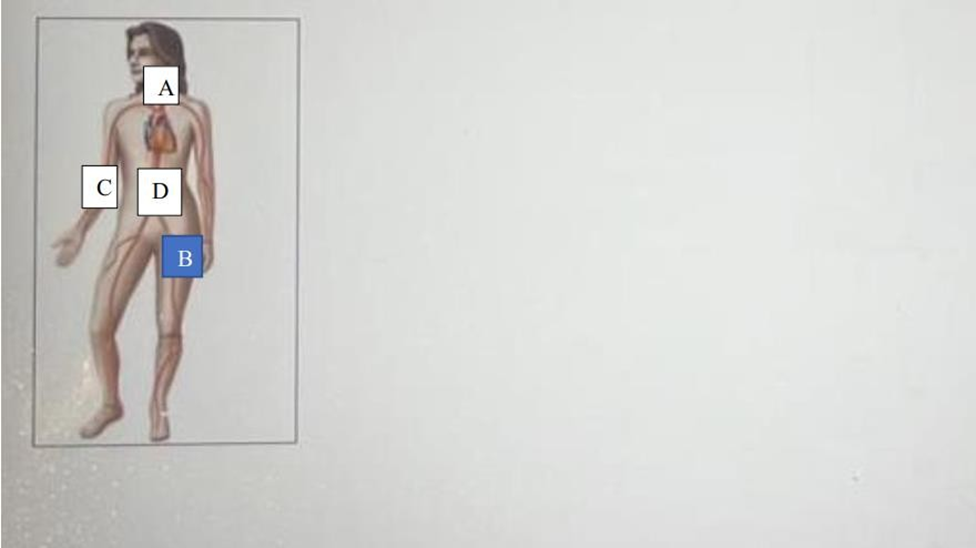To auscultate for a carotid bruit, the nurse places the stethoscope at what location (Select the correct location on the image. To change, click on a new location.)

A
B
C
D
The Correct Answer is A
A. The neck is the correct location for auscultating a carotid bruit. A carotid bruit is an abnormal sound heard over the carotid artery in the neck, typically indicative of turbulent blood flow due to a narrowing or blockage in the artery.
B. Auscultating the femoral region would not yield information about carotid bruits. The femoral region pertains to the upper thigh area and is not anatomically related to the carotid artery.
C. The cubital fossa is the inner elbow region and is not associated with auscultation for carotid bruits. It is typically used for auscultation of blood pressure using the brachial artery.
D. The navel (belly button) is not a relevant location for auscultation for carotid bruits. It is far from the carotid arteries and would not provide any meaningful information about carotid artery sounds.
Nursing Test Bank
Naxlex Comprehensive Predictor Exams
Related Questions
Correct Answer is C
Explanation
A. While repeated requests for attention from the nurse might indicate distress, they are not necessarily indicative of potential aggression or disruptive behavior.
B. Periodic sighing and shaking the head could suggest the client's emotional state, but they are not as indicative of potential aggression or disruptive behavior as argumentativeness and profanity.
C. Monitoring for argumentativeness and the use of profanity is crucial as they can escalate into disruptive or potentially aggressive behavior. It's important to assess the client's agitation level and ensure the safety of both the client and others on the mental health unit.
D. Decreased activity level and a change in affect may suggest a worsening of the client's mental state but are not immediate concerns in terms of safety on the unit.
Correct Answer is ["A","B","E"]
Explanation
A. Neurological status: Assessing the neurological status is crucial in the primary survey to
determine the client's level of consciousness, pupil reactions, and response to stimuli. This helps in identifying any potential brain injury or neurological deficits resulting from the fall.
B. Circulation: Evaluating circulation involves assessing the client's heart rate, blood pressure, and peripheral perfusion. In this scenario, the client's heart rate and blood pressure are provided in the nurse's notes, indicating the need to assess circulation as part of the primary survey.
C. Current medications: While important for the overall assessment and care of the client, assessing current medications is typically part of the secondary survey rather than the primary survey. The primary survey focuses on immediate life-threatening conditions.
D. Allergies: While allergies are essential information for the client's overall care, they are typically addressed during the secondary survey or during the history-taking process rather than as part of the primary survey.
E. Exposure: Assessing exposure involves ensuring the client is adequately covered and protected from environmental factors, especially in trauma situations where there may be significant blood loss or risk of hypothermia. This includes removing clothing to assess for additional injuries or bleeding.
F. Ventilation: While ventilation is crucial for assessing the client's respiratory status, including respiratory rate and effort, it is typically part of the primary survey rather than the primary survey itself. Assessing ventilation helps determine if the client is adequately breathing and oxygenating.
Whether you are a student looking to ace your exams or a practicing nurse seeking to enhance your expertise , our nursing education contents will empower you with the confidence and competence to make a difference in the lives of patients and become a respected leader in the healthcare field.
Visit Naxlex, invest in your future and unlock endless possibilities with our unparalleled nursing education contents today
Report Wrong Answer on the Current Question
Do you disagree with the answer? If yes, what is your expected answer? Explain.
Kindly be descriptive with the issue you are facing.
